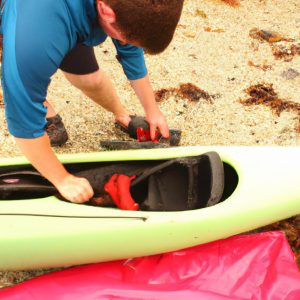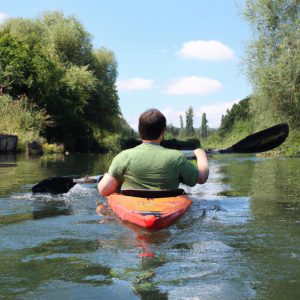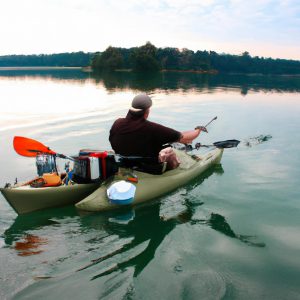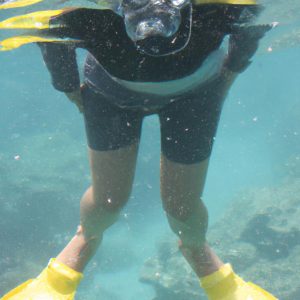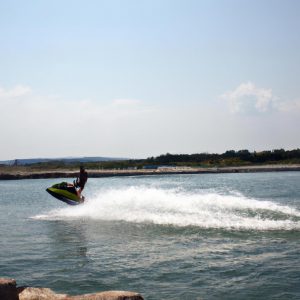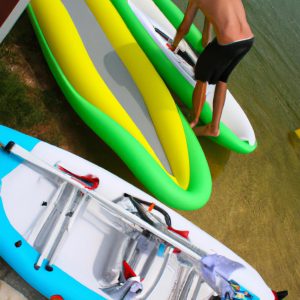Types of Kayaks: A Guide to Water Sports Must-Have Vessels
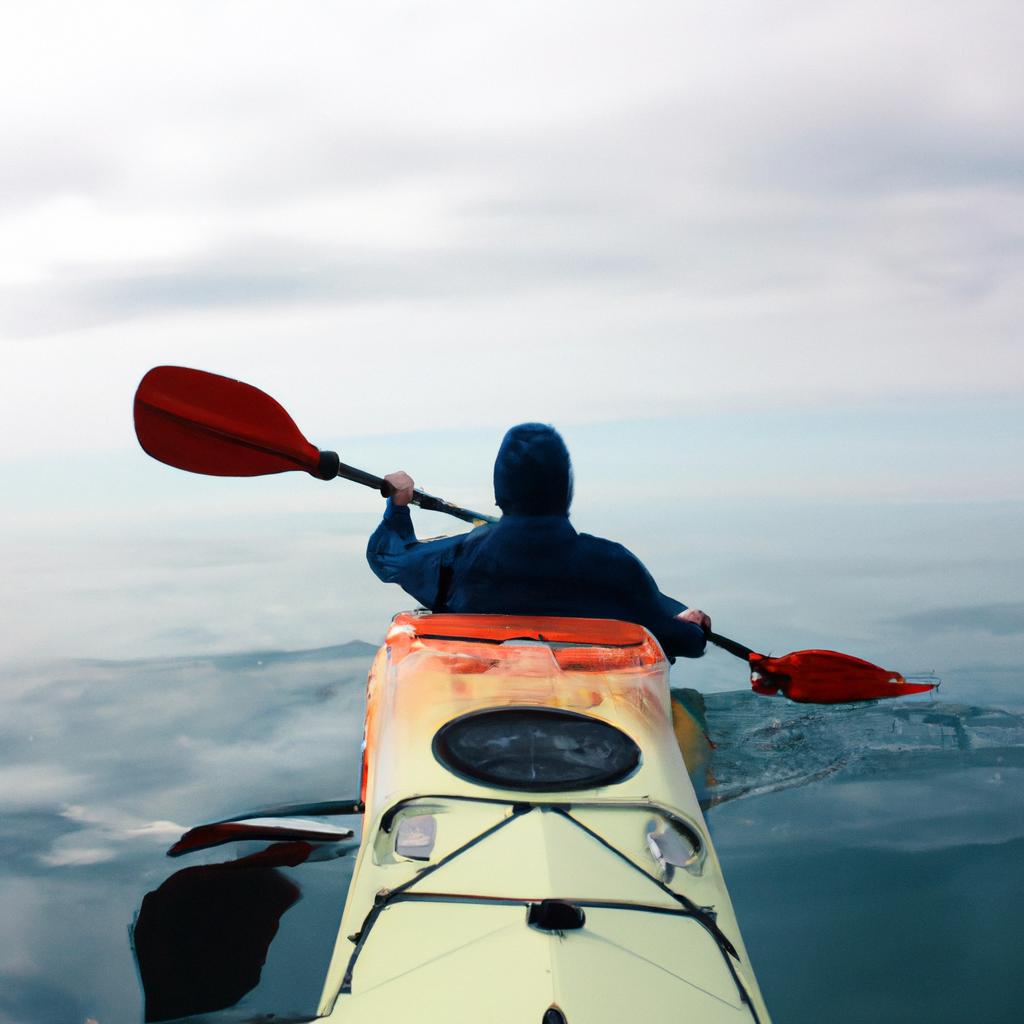
Kayaking is a popular water sport that offers individuals the opportunity to explore stunning waterways and enjoy the tranquility of nature. Whether paddling through calm lakes, challenging whitewater rapids, or navigating coastal waters, having the right kayak can greatly enhance one’s experience on the water. This article aims to provide a comprehensive guide to different types of kayaks, helping enthusiasts make informed decisions when choosing their vessel.
Imagine a scenario where an adventurous individual plans a weekend getaway to a picturesque lake nestled in the mountains. With its crystal-clear waters reflecting the surrounding scenery, this serene location promises endless opportunities for exploration and relaxation. As our hypothetical adventurer arrives at the lake, they are faced with numerous options for kayaks – each designed for specific purposes and environments. Understanding these various types of kayaks is crucial in ensuring maximum safety, comfort, and enjoyment during their time on the water.
In this guide, we will discuss four main categories of kayaks: recreational kayaks, touring/expedition kayaks, whitewater kayaks, and sea/touring kayaks. Each type has distinctive features tailored to meet specific needs and preferences of paddlers across various skill levels and desired activities. By delving into details such as design characteristics, materials used in construction, and key considerations when choosing a kayak, readers will gain valuable insights into selecting the right vessel for their kayaking adventures.
Recreational kayaks are perfect for beginners or casual paddlers looking to enjoy calm waters such as lakes, ponds, and slow-moving rivers. These kayaks typically have a wide and stable hull design, providing excellent stability and maneuverability. They often feature a spacious cockpit with comfortable seating, making them ideal for day trips or leisurely outings. Recreational kayaks are generally made from durable materials like polyethylene or ABS plastic, ensuring longevity and resistance to bumps and scrapes.
Touring/expedition kayaks, on the other hand, are designed for longer journeys and exploring more challenging water conditions. With sleeker profiles and narrower hulls, these kayaks offer improved speed and efficiency in the water. Touring kayaks also provide ample storage space for gear, making them suitable for multi-day expeditions. Commonly constructed using fiberglass or carbon fiber composites, they strike a balance between lightweight maneuverability and durability.
Whitewater kayaks are specifically built to navigate fast-moving rivers and rapids with ease. These kayaks often have a compact design with rounded bottoms that allow for quick turns and responsive handling. They come equipped with specialized features such as reinforced hulls to withstand impacts from rocks and waves. Whitewater kayaks can be made from materials like high-density polyethylene or roto-molded plastic to handle the demands of rough river environments.
For those seeking adventure along coastal waters or open seas, sea/touring kayaks offer stability, speed, and storage capacity necessary for long-distance trips. With longer lengths and narrower profiles compared to recreational kayaks, sea/touring kayaks excel in tracking straight through waves and currents. These vessels may incorporate advanced features such as rudders or skegs to enhance directional control in windy conditions. Sea/touring kayaks are commonly constructed using fiberglass or thermoformed plastic for optimal performance and durability in marine environments.
When choosing a kayak, it is essential to consider factors such as skill level, intended use, budget, and storage space. Additionally, trying out different models through rentals or demo days can provide valuable hands-on experience to determine the best fit. While this guide provides an overview of various kayak types, consulting with experts at local paddling shops or seeking guidance from experienced kayakers can further assist in making an informed decision.
With the right kayak in tow, our adventurous individual can embark on their weekend getaway fully prepared to immerse themselves in the beauty of nature while enjoying the thrill of kayaking. Whether leisurely exploring serene lakes, conquering challenging rapids, embarking on multi-day expeditions, or venturing into open waters, a well-chosen kayak will undoubtedly enhance their overall experience and allow them to create lasting memories on their kayaking adventures.
Recreational Kayaks
Imagine yourself gliding peacefully along a calm lake on a sunny day, the gentle rhythm of your paddle breaking the stillness of the water. Recreational kayaking offers individuals an opportunity to escape from the demands of daily life and connect with nature in a serene and tranquil setting. This section will explore the features and benefits of recreational kayaks, providing insights into why they are a popular choice for leisurely paddling adventures.
One example that highlights the appeal of recreational kayaks is Sarah’s experience. Sarah, an amateur kayaker, decided to spend her weekend exploring a nearby river. She opted for a recreational kayak due to its stability and maneuverability in calm waters. With its wide hull design, she felt confident as she navigated through meandering streams and enjoyed glimpses of wildlife along the shoreline.
- Versatility: These kayaks can be used in various bodies of water such as lakes, rivers, and slow-moving coastal areas.
- Stability: The wider hull design provides increased stability, allowing beginners or less experienced paddlers to feel secure while on the water.
- Ease of use: Recreational kayaks often have straightforward designs that make them user-friendly for both novices and experts alike.
- Storage capacity: Many models feature ample storage space for carrying personal belongings or gear needed for a day out on the water.
In addition to these notable characteristics, it is worth examining some key specifications commonly associated with recreational kayaks (see table below). These measurements provide potential buyers with essential information when selecting their vessel:
| Specification | Description |
|---|---|
| Length | Typically ranges between 9 to 12 feet |
| Width | Usually around 28 to 32 inches |
| Weight Capacity | Can support up to 250-350 pounds |
| Cockpit Size | Varies between 36 to 48 inches in length and 18 to 22 inches in width |
In summary, recreational kayaks offer individuals a chance to unwind while exploring the waterways. Their versatility, stability, ease of use, and storage capacity make them an appealing option for those seeking leisurely paddling experiences.
Transitioning smoothly from discussing recreational kayaks, let us now turn our attention to touring kayaks. These vessels are designed with specific features that cater to more experienced paddlers aiming for longer journeys on open waters.
Touring Kayaks
Recreational kayaks provide paddlers with a versatile and user-friendly option for enjoying calm waters. These kayaks are designed to be stable, easy to maneuver, and comfortable for extended periods of time on the water. For example, imagine yourself gliding through a serene lake surrounded by picturesque scenery in your recreational kayak—a truly idyllic experience.
To further understand the benefits of recreational kayaks, let’s explore some key characteristics that make them an appealing choice:
- Stability: Recreational kayaks often have wider hulls, which enhance stability on flatwater conditions. This feature enables beginners or those seeking leisurely outings to feel confident as they paddle along.
- Maneuverability: With their shorter length and responsive design, recreational kayaks allow paddlers to navigate tight spaces or negotiate obstacles effortlessly.
- Comfort: Many recreational kayaks come equipped with padded seats and adjustable footrests, ensuring optimal comfort during long trips.
- Storage Space: Most models offer ample storage compartments—both dry hatches and bungee cords—allowing you to bring along essentials such as extra clothing layers or snacks without worrying about space constraints.
Table: Key Features of Recreational Kayaks
| Feature | Description |
|---|---|
| Stability | Wide hull provides enhanced stability for beginners |
| Maneuverability | Shorter length allows easy navigation |
| Comfort | Padded seats and adjustable footrests ensure comfort |
| Storage Space | Ample compartments accommodate personal belongings |
Engaging in water sports activities can evoke feelings of tranquility, adventure, and joy. The peace that comes from being out on the water combined with the thrill of exploration makes recreational kayaking an enticing pastime. Whether you’re looking for a relaxing day trip or want to try fishing from your kayak, these vessels are an excellent choice.
Transitioning seamlessly into our next section, let’s now delve into the world of touring kayaks and discover how they differ from their recreational counterparts. Whichever type of kayak you choose, it is important to consider your specific needs and preferences before making a decision.
Whitewater Kayaks
Building on the different types of kayaks already discussed, let us now explore another popular category – Whitewater Kayaks.
Whitewater kayaking is an exhilarating water sport that involves navigating fast-moving rivers and rapids. These specialized kayaks are designed to withstand the challenging conditions encountered in whitewater environments. To understand their features and benefits, consider the following example:
Imagine a skilled paddler seeking an adrenaline rush as they conquer class IV rapids in a remote river canyon. They need a kayak that offers maneuverability, stability, and durability to handle the tumultuous waters.
When it comes to whitewater kayaks, there are several key factors to consider:
-
Size: Whitewater kayaks are typically shorter in length compared to other types of kayaks. This compact size allows for increased maneuverability when navigating through narrow passages or making quick turns.
-
Design: The design of these kayaks focuses on enhancing stability and control. They often feature rounded hulls with pronounced rocker (curvature from bow to stern) for better agility on turbulent waters.
-
Outfitting: Whitewater kayaks come equipped with adjustable footrests, thigh braces, and hip pads that provide a snug fit for improved control and comfort while tackling rapids.
-
Safety Features: Due to the risks associated with whitewater kayaking, these vessels incorporate safety elements such as grab handles, flotation bags, and sturdy bulkheads that help keep the kayak buoyant even if it capsizes.
To illustrate further how various whitewater kayak models differ based on their characteristics, here is a comparison table showcasing four popular options:
| Model | Length (ft) | Weight Capacity (lbs) | Skill Level |
|---|---|---|---|
| Dagger Mamba 8.6 | 8’6″ | 250-300 | Intermediate/ Advanced |
| Jackson Zen 3.0 | 9’5″ | 200-260 | Beginner/ Intermediate |
| Pyranha Burn III | 8’6″ | 180-250 | Advanced |
| Liquidlogic Braaap | 8’11” | 160-230 | Intermediate |
These kayaks offer varying lengths, weight capacities, and skill level requirements to cater to the diverse needs of whitewater enthusiasts.
These specialized vessels provide anglers with stability, storage options, and other features tailored to their fishing needs. So let’s dive into the world of angling on water!
Fishing Kayaks
Now that we have explored the world of whitewater kayaks, let’s delve into another popular type of kayak – fishing kayaks. Fishing kayaks are specially designed to cater to the needs of anglers who enjoy combining their love for paddling with a day out on the water in search of fish.
To illustrate the versatility and practicality of fishing kayaks, consider this example: John is an avid angler who enjoys spending his weekends exploring various lakes and rivers in search of his next big catch. He recently purchased a fishing kayak equipped with rod holders, storage compartments for tackle boxes, and even a built-in fishfinder. With its stable design and comfortable seating, John can effortlessly maneuver through different fishing spots while keeping all his gear within reach.
When it comes to choosing the right fishing kayak, there are several key features to consider:
- Stability: A stable kayak ensures better balance when casting lines or reeling in fish.
- Storage Space: Sufficient storage compartments allow anglers to organize their equipment efficiently.
- Comfortable Seating: Long hours spent on the water require comfortable seating options.
- Integration with Accessories: Attachments such as rod holders, fishfinders, and anchor systems enhance the overall fishing experience.
| Feature | Description |
|---|---|
| Stability | Wide hull design provides excellent stability even in choppy waters. |
| Storage Space | Multiple hatches and bungee cords offer ample space for storing gear and catch. |
| Comfortable Seating | Adjustable seats with padding provide comfort during long fishing trips. |
| Accessory Integration | Built-in rod holders and attachment points accommodate additional accessories like fishfinders or GPS devices. |
Choosing a well-equipped fishing kayak that meets your specific requirements will make your angling adventures more enjoyable and successful. Whether you prefer targeting smallmouth bass in freshwater lakes or battling with saltwater giants, a fishing kayak can be an excellent addition to your gear.
Moving on from fishing kayaks, let’s now explore another popular type of kayak – sit-on-top kayaks. These versatile vessels have gained popularity among paddlers for their ease of use and suitability for various water activities.
Sit-on-Top Kayaks
Imagine yourself gliding across the calm waters of a serene lake, the sun gently warming your skin as you soak in the beauty of nature. The versatility and ease of use offered by sit-on-top kayaks make them an ideal choice for recreational water activities. Whether you are a beginner or an experienced paddler, these kayaks provide a stable and enjoyable experience on the water.
Sit-on-top kayaks offer several advantages that contribute to their popularity among water sports enthusiasts:
- Accessibility: With their open cockpit design, sit-on-top kayaks are incredibly easy to get into and out of. This accessibility makes them suitable for individuals with limited mobility or those who may feel claustrophobic in traditional closed-cockpit designs.
- Self-bailing capability: One key feature of sit-on-top kayaks is their self-bailing system. This means that any water that enters the kayak will drain away through scupper holes, ensuring that you stay dry during your adventure.
- Stability: Due to their wider hull design, sit-on-top kayaks offer excellent stability even in choppy waters. This stability allows beginners to feel more confident while paddling and provides peace of mind when venturing into unknown territories.
- Versatility: Sit-on-top kayaks can be used for various water activities ranging from leisurely paddles along calm lakes to thrilling adventures in coastal areas or even surfing small waves.
To further illustrate the benefits of sit-on-top kayaks, consider the following table showcasing some popular models available on the market:
| Model | Weight Capacity (lbs) | Length (ft) | Price Range ($) |
|---|---|---|---|
| Ocean Kayak | 250 | 10 | $500 – $700 |
| Perception | 350 | 12 | $800 – $1000 |
| Wilderness | 300 | 9 | $600 – $800 |
| Hobie | 400 | 13 | $1200 – $1500 |
Sit-on-top kayaks provide a gateway to unforgettable experiences on the water, allowing individuals of all skill levels to immerse themselves in nature’s beauty. Their accessibility, stability, and versatility make them an excellent choice for those seeking adventure or simply looking to relax and enjoy some quality time outdoors.
Transitioning seamlessly into our next section about inflatable kayaks, we will explore another type of kayak that offers unique advantages and appeals to a different set of water sports enthusiasts.
Inflatable Kayaks
Types of Kayaks: A Guide to Water Sports Must-Have Vessels
Imagine embarking on a thrilling kayaking adventure along the picturesque coastline. As you paddle through calm waters, you notice a group of inflatable kayaks gliding effortlessly over the waves. These versatile vessels have gained popularity in recent years due to their portability and ease of use.
Inflatable kayaks offer numerous advantages that make them an appealing choice for water sports enthusiasts. Firstly, their lightweight nature allows for easy transportation and storage. Unlike traditional hard-shell kayaks, which require dedicated roof racks or ample garage space, inflatable kayaks can be deflated and packed into a compact bag, making them ideal for travelers or those with limited storage options.
Secondly, inflatable kayaks are incredibly durable and resistant to punctures. Made from robust materials such as PVC or Hypalon, these kayaks can withstand encounters with rocks, branches, and other potential hazards without compromising their structural integrity. This durability ensures that your investment will last for many seasons of exciting paddling adventures.
Furthermore, inflatable kayaks provide exceptional stability and maneuverability on the water. With wider hull designs and multiple air chambers providing buoyancy, these kayaks offer a secure platform even for novice paddlers. Whether navigating gentle rivers or tackling ocean swells, inflatable kayaks grant confidence and control in various conditions.
To illustrate further why inflatable kayaks have become so popular among outdoor enthusiasts worldwide, consider the following emotional benefits they offer:
- Versatility: Suitable for recreational use on lakes or whitewater adventures.
- Accessibility: Easy entry-level option for beginners looking to explore waterways.
- Freedom: Portable design allows spontaneous kayak trips wherever desired.
- Affordability: Budget-friendly alternative compared to rigid-hull models.
Additionally, here is a breakdown showcasing some key features of different types of inflatable kayaks:
| Type | Features | Suitable For |
|---|---|---|
| Recreational | Stable and comfortable seating | Leisurely paddling |
| Whitewater | Reinforced hull for increased durability | Rough river conditions |
| Touring | Extended length and sleek design | Long-distance exploration |
| Fishing | Built-in rod holders and storage compartments | Angling enthusiasts |
In summary, inflatable kayaks have revolutionized the world of water sports by offering a portable, durable, and versatile alternative to traditional hard-shell kayaks. Their lightweight nature allows for easy transportation and storage while maintaining exceptional stability on the water. With various types available catering to different preferences, inflatable kayaks continue to gain popularity among outdoor enthusiasts seeking thrilling adventures or serene explorations along tranquil waterways.

